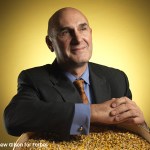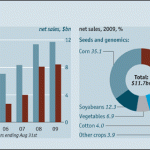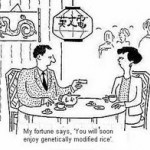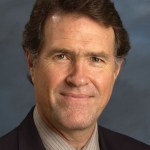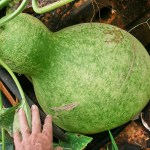GMO
Here is another interesting story about Monsanto, in Forbes magazine. The article manages to avoid calling Monsanto all good or all bad and instead looks at what Monsanto means for the future productivity of the global food supply.
Thanks to Alex Palazzo for alerting me to the article The Paranoid Style in American Science by Daniel Engber of Slate.
This is a three-part series on radical skepticism and the rise of conspiratorial thinking about science. Unfortunately it is all too familiar. As Alex notes, the series discusses how certain people (i.e. climate skeptics, the ID movement, and the tobacco industry) have cultivated a notion of super-skepticism in an attempt to discredit current scientific consensus. Sadly, crop genetic engineering has also often been the target of such attacks.
The book I wrote with my husband…
The word is spreading- we can feed the world without damaging it, if we can entertain some new ideas.
Check out Paul Voosen's article in the NYT and let me know what you think.
On this blog, I will no longer be attempting to explain the difference between genetic engineering and molecular breeding. Instead I will simply refer those interested to Paul Voosen's fine article on the subject published in Scientific American and the New York Times today.
If you are a poor farmer in China, do you care if Monsanto dominates the seed industry in the US?
Apparently not. Several recent reports indicate a rapid launch of GE crops in the less developed world- independent of the US corporate seed industry.
The first news story, reported in the Wall Street Journal and by Reuters is that China has approved release of the worlds first genetically engineered rice. The Bt rice, which was developed by China's Huazhong Agricultural University, is predicted to reduce the use of insecticides by 80 percent while raising yields by as much as 8 percent. This is…
Guest blog by Mateo Burtch.
Dear Ms. Doctor Ronald--
I recently had the opportunity to read Simplicity Today, the magazine of the University of Reed alumni association, and its article on you (or someone who looks like you and has the same name as you and is apparently you). I found it to be fascinating and educational in the extreme, so extreme that I actually burned myself on it. I also found it very easy to read, once I mastered the "trick" of holding the magazine rightside-up.
Although, because of time constraints, I was only able to skim a few of the shorter paragraphs, I believe I got…
Guest blogger Rob Hebert is a second-year student at Georgetown Law. Before moving to DC, he lived in Brooklyn, NY, just blocks from a bar that had over twenty-five beers on tap and thirty arcade machines that all played for a quarter. He can draw you a pretty interesting graph relating "Drinks Consumed" to "Last Score on Pac-Man."
Consumer advocacy groups are a strange animal. It seems that for every influential lobbying group with a senator's ear, there are hundreds or thousands with only vague mission statements and no clear agenda for attaining their stated goals. I once spent a summer…
The Daily Star of Dhaka reports today that flood-tolerant rice will soon be officially released in Bangladesh.
The flood-tolerant rice varieties (called Sub1- rice) can help farmers, many who live on less than $1/day, dramatically increase yield during floods.
Dave Mackill of the International Rice Research Institute (formerly of UC Davis) led the precision breeding efforts. The team introduced the Sub1 gene into BR-11 and three other varieties that are popular with farmers and consumers. The new BR-11 Sub1 variety has been embraced by farmers in field trials because it is effectively…
The Changemakers international online community selected biofortified, a group website devoted to providing factual information and fostering discussion about plant genetics, especially genetic engineering, as the grand prize winner in the GMO Risk or Rescue Competition. This would not have been possible without the leadership of Karl Haro von Mogel, graduate student and blogger Anastasia Bodnar, our Australian colleague David Tribe and the votes of the science blogging community. Thanks all.
Here is the announcment:
Our entire team is excited to highlight your idea and your efforts on…
Kent J. Bradford, Professor of Plant Sciences and Academic Director of the Seed Biotechnology Center at UC Davis, is today's guest blogger.
Ever since our ancestors adopted an agricultural lifestyle about 10,000 years ago, our own sustainability has been intimately tied with that of our food production systems. Those systems currently support 6.7 billion humans, or more correctly, adequately support about 5.9 billion with another 800 million or so suffering from food insecurity, malnutrition or hunger. Compare that with the 1960's when the world population was 3 billion, with 1 billion…
When it comes to plants, there can be no gene flow without two compatible partners. And most plants are quite choosy, preferring a close relative rather than someone outside its family. Pollen travels in gusts of wind, on the pollen basket of bees, as cargo of flies or in the hands of human plant breeders. If the pollen alights upon a compatible mate, there will be fertilization and the resulting seed will carry the genes of the parents. What will happen then if a transgene from a genetically engineered crop plant cross-pollinates with wild relatives?
A new study in PNAS suggests that we…
The latest comments on my new blog reflect ample confusion about whether or not plant genetics can help poor farmers in India.
To demonstrate the power of genetics, I have posted a time-lapse video (4 months) showing the performance of a genetically improved rice in a flooded field plot at the International Rice Research Institute.
This video, shot by Gene Hettle, shows survival of the submergence tolerance (Sub1) rice, developed by our team, after a 17 day flood.
The Sub1 rice yielded about 3 fold more in these field trials. The IRRI team has also introduced the Sub1 gene into rice…
A long-sought goal in genetics has been to develop therapies that can use correctly functioning genes to replace genes with defects. If we had the technology to predictably modify our genomes, we would have the ability to cure many diseases instead of having to place people on medications for their entire lives.
For a long time, gene therapy has remained an elusive dream. But, in the past few years the dream has come closer to reality, especially in the case of ten children, who live because of researchers who kept that dream in sight (1).
Figure 1. Random children
Technorati Tags:…
